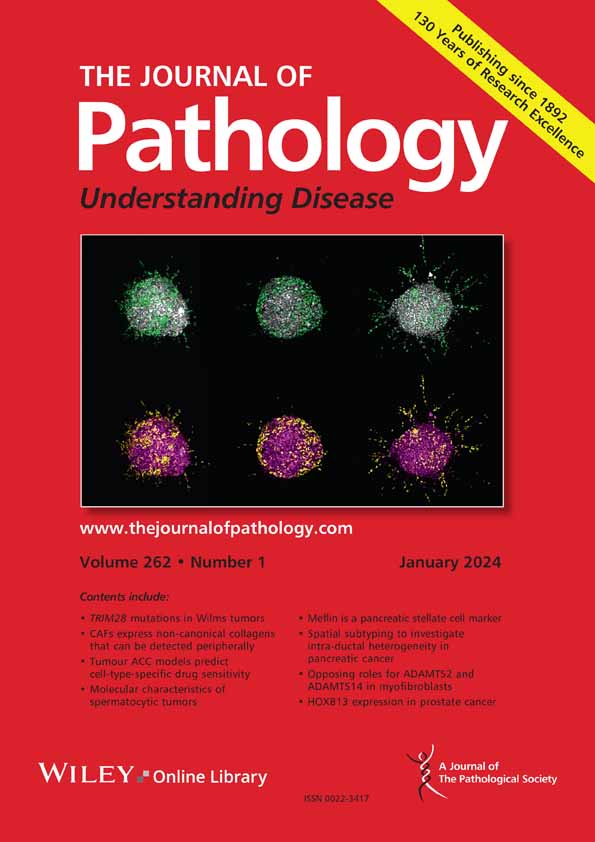Olli Metsälä, Gudrun Wahlström, Neha Goel, Mitro Miihkinen, Pekka Taimen, Johanna Schleutker
下载PDF
{"title":"Spatial profiling of ANO7 in prostate tissue: links to AR-signalling-associated lipid metabolism and inflammation","authors":"Olli Metsälä, Gudrun Wahlström, Neha Goel, Mitro Miihkinen, Pekka Taimen, Johanna Schleutker","doi":"10.1002/path.6405","DOIUrl":null,"url":null,"abstract":"<p>Prostate cancer (PrCa) is highly prevalent in the Western world. Currently, however, there are many unmet needs in PrCa care, for example in distinguishing between clinically significant and indolent cases in early phases of the disease. <i>ANO7</i> is a prostate-specific gene associated with PrCa risk and prognosis, but its exact function in the prostate remains unclear. This study investigates the role of <i>ANO7</i> in benign prostatic epithelium using spatial transcriptomics by examining differences between <i>ANO7</i>-expressing and non-expressing epithelial regions and their corresponding stromal compartments. A total of 18,676 protein-coding genes were assessed from prostatectomy samples collected from patients with localised prostate cancer. In the collected sample cohort, ANO7 exhibited a distinct, heterogeneous, on–off epithelial expression pattern, enabling an in-depth analysis of ANO7-dependent processes. <i>ANO7</i>-positive epithelium was predominantly enriched with luminal epithelial cells and a specific NK cell subtype, CD56bright. In contrast, <i>ANO7</i>-negative regions were characterised by enrichment of club cells, inflammation, and features of proliferative inflammatory atrophy. Gene-set enrichment analysis revealed that <i>ANO7</i> expression is associated with androgen receptor (AR) signalling and lipid metabolism. A detailed analysis of differentially expressed genes identified an ANO7- signature, which consisted of genes co-expressed with <i>ANO7</i> in luminal cells, that demonstrated high consistency in bulk RNA-sequencing (RNA-seq) data. The ANO7-signature was enriched for AR-regulated genes, which highlighted lipid metabolism processes, particularly arachidonic acid metabolism, as a key metabolic feature of the <i>ANO7</i>-positive epithelium. Furthermore, the ANO7-signature demonstrated clinical significance in low-grade PrCa, correlating with a better response to therapy. In summary, these results highlight the potential role of <i>ANO7</i> in regulating lipid metabolism associated with androgen signalling in benign luminal cells and low-grade cancer, reinforcing the hypothesis that <i>ANO7</i> functions as a tumour suppressor. © 2025 The Pathological Society of Great Britain and Ireland.</p>","PeriodicalId":232,"journal":{"name":"The Journal of Pathology","volume":"265 4","pages":"518-531"},"PeriodicalIF":5.2000,"publicationDate":"2025-02-20","publicationTypes":"Journal Article","fieldsOfStudy":null,"isOpenAccess":false,"openAccessPdf":"https://onlinelibrary.wiley.com/doi/epdf/10.1002/path.6405","citationCount":"0","resultStr":null,"platform":"Semanticscholar","paperid":null,"PeriodicalName":"The Journal of Pathology","FirstCategoryId":"3","ListUrlMain":"https://pathsocjournals.onlinelibrary.wiley.com/doi/10.1002/path.6405","RegionNum":2,"RegionCategory":"医学","ArticlePicture":[],"TitleCN":null,"AbstractTextCN":null,"PMCID":null,"EPubDate":"","PubModel":"","JCR":"Q1","JCRName":"ONCOLOGY","Score":null,"Total":0}
引用次数: 0
引用
批量引用
Abstract
Prostate cancer (PrCa) is highly prevalent in the Western world. Currently, however, there are many unmet needs in PrCa care, for example in distinguishing between clinically significant and indolent cases in early phases of the disease. ANO7 is a prostate-specific gene associated with PrCa risk and prognosis, but its exact function in the prostate remains unclear. This study investigates the role of ANO7 in benign prostatic epithelium using spatial transcriptomics by examining differences between ANO7 -expressing and non-expressing epithelial regions and their corresponding stromal compartments. A total of 18,676 protein-coding genes were assessed from prostatectomy samples collected from patients with localised prostate cancer. In the collected sample cohort, ANO7 exhibited a distinct, heterogeneous, on–off epithelial expression pattern, enabling an in-depth analysis of ANO7-dependent processes. ANO7 -positive epithelium was predominantly enriched with luminal epithelial cells and a specific NK cell subtype, CD56bright. In contrast, ANO7 -negative regions were characterised by enrichment of club cells, inflammation, and features of proliferative inflammatory atrophy. Gene-set enrichment analysis revealed that ANO7 expression is associated with androgen receptor (AR) signalling and lipid metabolism. A detailed analysis of differentially expressed genes identified an ANO7- signature, which consisted of genes co-expressed with ANO7 in luminal cells, that demonstrated high consistency in bulk RNA-sequencing (RNA-seq) data. The ANO7-signature was enriched for AR-regulated genes, which highlighted lipid metabolism processes, particularly arachidonic acid metabolism, as a key metabolic feature of the ANO7 -positive epithelium. Furthermore, the ANO7-signature demonstrated clinical significance in low-grade PrCa, correlating with a better response to therapy. In summary, these results highlight the potential role of ANO7 in regulating lipid metabolism associated with androgen signalling in benign luminal cells and low-grade cancer, reinforcing the hypothesis that ANO7 functions as a tumour suppressor. © 2025 The Pathological Society of Great Britain and Ireland.
前列腺组织中ANO7的空间谱:与ar信号相关的脂质代谢和炎症的联系
前列腺癌(PrCa)在西方世界非常普遍。然而,目前在PrCa护理方面有许多未满足的需求,例如在疾病早期阶段区分临床显著病例和惰性病例。ANO7是一种前列腺特异性基因,与PrCa风险和预后相关,但其在前列腺中的确切功能尚不清楚。本研究通过检测ANO7表达和不表达的上皮区域及其相应的间质室的差异,利用空间转录组学研究了ANO7在良性前列腺上皮中的作用。从局部前列腺癌患者收集的前列腺切除术样本中,共评估了18,676个蛋白质编码基因。在收集的样本队列中,ANO7表现出独特的、异质的、开关的上皮表达模式,从而能够深入分析ANO7依赖的过程。ano7阳性上皮主要富集腔上皮细胞和特异性NK细胞亚型CD56bright。相反,ano7阴性区以俱乐部细胞富集、炎症和增生性炎性萎缩为特征。基因集富集分析显示ANO7的表达与雄激素受体(AR)信号传导和脂质代谢有关。对差异表达基因的详细分析发现了ANO7-特征,该特征由在腔细胞中与ANO7共表达的基因组成,在大量rna测序(RNA-seq)数据中显示出高度一致性。ar调节基因的ano7特征丰富,这突出了脂质代谢过程,特别是花生四烯酸代谢,是ano7阳性上皮的关键代谢特征。此外,ano7特征在低级别PrCa中显示出临床意义,与更好的治疗反应相关。总之,这些结果强调了ANO7在调节良性腔细胞和低级别癌症中与雄激素信号相关的脂质代谢中的潜在作用,强化了ANO7作为肿瘤抑制因子的假设。©2025英国和爱尔兰病理学会。
本文章由计算机程序翻译,如有差异,请以英文原文为准。






 求助内容:
求助内容: 应助结果提醒方式:
应助结果提醒方式:


